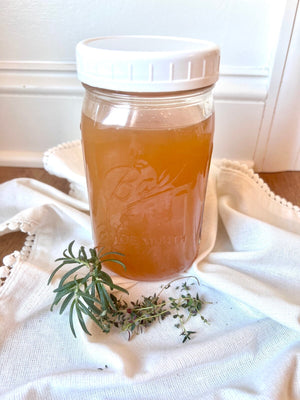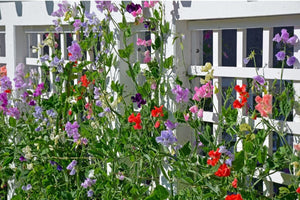Growing Mealycup Blue Sage (Salvia farinacea) for Beauty and Biodiversity
Herb growing tipsGrowing native plants can improve the biodiversity of your home landscape. Blue Sage is a particularly important wildflower that provides a valuable nectar source for pollinators in your garden. Learn more about Mealycup Blue Sage and how to grow it for beauty and biodiversity.

Get to Know Mealycup Blue Sage
There are several plants that go by the common name “blue sage,” and all of them are beautiful. Our Blue Sage is Salvia farinacea, sometimes known as mealycup sage or mealy blue sage. "Mealy" refers to the powdery or grainy texture that can be found on the leaves and stems, resembling meal or flour, which makes it easy to distinguish from other blue sages.
Mealy blue sage is a perennial wildflower that’s native to Texas, Mexico, and the southwestern United States. This herb is hardy in zones 7-10 but is also grown as an annual outside of this range because it is so fast-growing. It has deep violet-blue to purple flowers that form clusters of spikes. Blue Sage makes for a charming addition to any garden. This native gem is beautiful and provides valuable nectar for pollinators such as hummingbirds, bees, and butterflies, strengthening the local ecosystem.
Growing Blue Sage from Seed
Starting mealy blue sage from seed is generally a simple process. Start your plants indoors 10 weeks before the last frost date and barely cover the seeds, as they require light for germination. If you choose to direct sow, plant blue sage seeds outdoors in a well-drained sunny spot after the last frost. Maintain even soil moisture until germination, which typically occurs within two to three weeks. After the second set of true leaves appear, and seedlings are about 4 inches high, they should be either transplanted to their final home or thinned if sown directly. Space the plants about 12 to 18 inches apart.
Growing Mealy Blue Sage
Mealycup sage is best suited to well-drained, moderately fertile soil and full sun. However, this herb is fairly adaptable to other soil conditions and can tolerate partial shade, so it’s a versatile choice that can fill in empty spaces in the garden. Once established, mealy blue sage is drought-tolerant, making it an excellent option for low-maintenance or xeriscape gardens.
Blue sage doesn’t have heavy nutrient needs. A light application of compost or balanced fertilizer is generally enough to support healthy growth and prolific blooming.
Early spring pruning to remove dead woody material will encourage a bushier growth habit and more abundant flowering. Deadheading spent flower spikes during the growing season can also help to prolong the bloom period.

Ornamental and Ecological Value
Eye-Catching Beauty
With alluring blue blooms and attractive foliage, Salvia farinacea is an ideal ornamental plant to add to your garden. Its manageable height makes it suitable for a variety of settings, from borders to container gardens.
Pollinator Paradise
The rich nectar of its deep blue flowers attracts a variety of pollinators. Including Blue Sage in your garden not only adds beauty but also promotes biodiversity by providing a valuable nectar source for hummingbirds, bees, butterflies, and other beneficial pollinators.
Potpourri
Although mealycup blue sage isn’t typically used as a culinary or medicinal herb, the aromatic leaves of Salvia farinacea have a similar scent to culinary sage. They can be dried and included in sachets or potpourri mixes, adding a subtle but pleasant aroma.
Salvia farinacea, or Blue Sage, is a lovely herb that is irresistible to pollinators and humans alike. Native plants like Blue Sage are also invaluable for preserving local ecosystems because they are well-adapted to their environment and support native wildlife. By growing from seed, you’re also increasing the genetic diversity of your garden, making it more resilient to changing weather conditions, disease, and other factors that can result from growing solely from cuttings or root division. Add this resilient native herb to your garden and enjoy the benefits!
Written by Teresa Chandler
Found this information helpful? Share it with your gardening friends!










Leave a comment